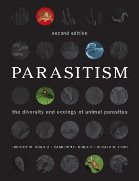Parasitism: The Diversity and Ecology of Animal Parasites
 Timothy M Goater, Cameron P Goater and Gerald W Esch
Timothy M Goater, Cameron P Goater and Gerald W Esch
Cambridge University Press, £95.00 hardback, £40.00 paperback
The second edition of this classic reference book on parasitology is well worth the 13 year wait. It is more theoretical than seen previously and offers a superbly presented synthesis of its twin central themes – the diversity of parasites and their ecology. The interdisciplinary approach considers the host-parasite relationship at all levels, from molecular, via whole organism, to entire communities.
An underlying concept is that the complex interactions observed in parasitism are fundamentally ecological and driven by co-evolution. Hence, the authors take great pains to stress how natural selection has shaped parasite life cycles and life histories. All the major groups of animal parasites are examined, and what they are and how they live are explained. Also chronicled are their biogeography, evolution and the way they profoundly influence their host populations in regard to physiological, biochemical, immunological and pathological manifestations.
Eight of the 17 chapters are new since the first edition and the remainder are significantly rewritten. The new material reflects the immense advances made in systematics, bioinformatics, genomics and biodiversity over the last decade and so acknowledges how today's generation of biologists perceive the world.
Several textboxes containing explanations or anecdotal asides and in excess of 300 illustrations increase the book's accessibility. While the primary target audience for Parasitism is advanced undergraduate and postgraduate students of biology, ecology, conservation biology, and biomedical and veterinary sciences, established academics in these disciplines would also find this a valuable resource.


